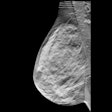
Healthcare reforms such as accountable care organizations (ACOs) appear to boost utilization rates for screening mammography -- for some demographic groups by as much as 42%. This suggests that incentive-based programs like ACOs could boost quality and cut costs, according to a new study published online September 20 in Radiology.
The findings offer some positive feedback in the midst of a transition in the U.S. from fee-for-service payment models to value-based ones, according to lead author Dr. Anand Narayan, PhD, of Johns Hopkins Hospital in Baltimore.
"As we evolve as a country toward different payment models, radiology has to be actively engaged -- and mammography screening is a good place to have a large, population-based impact," he told AuntMinnie.com. "It's a screening test that naturally works well in the ACO model."
What's an ACO?
ACOs are a tool suggested by the Medicare Shared Savings Program (MSSP), which was established as part of the Affordable Care Act (ACA). The MSSP is intended to improve the quality of care for Medicare beneficiaries while reducing unnecessary costs, and it allows eligible providers and hospitals to create and participate in ACOs to do this, wrote Narayan and colleagues Dr. Susan Harvey and Dr. Daniel Durand, also of Johns Hopkins (Radiology, September 20, 2016).
There are financial incentives to encourage the formation of ACOs, but groups must demonstrate care quality improvements in several areas to unlock these benefits. Screening mammography is one of these areas. In fact, it is the only imaging-related metric in the MSSP, according to the researchers.
"We [hypothesized] that financial incentives associated with improving screening mammography use would lead to significant increases in screening mammography use in participating ACOs," they wrote.
Narayan and colleagues used Medicare data to try to evaluate screening mammography utilization at 333 ACOs between 2012 and 2014. The main outcome metric for the study was what is called the ACO-20 measure, which is the percentage of women ages 40 to 69 who undergo screening mammography within 24 months; this metric is one of 33 that Medicare has selected to assess ACO performance.
Of these 333 groups, 20.4% were in the North, 40.1% were in the South, 18.5% were in the Midwest, and 14.6% were in the West. Screening mammography use varied across ACOs, and Narayan's group found significant differences across regions: The Midwest had the highest rates, while the South had the lowest rates.
Of the total participating ACOs, 208 (62.4%) reported longitudinal data that the researchers could use.
These 208 groups showed a small but statistically significant increase of 2.6% in mammography screening rates during the time frame, with 61.6% of ACOs reporting improvements. In fact, compared with baseline rates of mammography screening use, there were increases among some ACOs of up to 42.2% -- comparable to some of the most successful interventions to improve screening compliance (such as offering free, onsite mammography; calling patients and/or sending them written material; group health education sessions; peer counseling; and home visits).
"Widely known strategies used by ACOs to improve screening mammography use include using both insurance claims and electronic health record data to identify patients who have not undergone screening within a defined time period and then targeting these patients with outbound communications," the group wrote.
These results were not seen in traditional fee-for-service populations during the same time period, where the rate of mammography screening was unchanged or declined, according to the researchers.
Thinking globally
So why isn't everyone in an ACO? The cost-benefit analysis may not look all that great at first, Narayan said.
"For the first few years an ACO is in operation, there are some savings generated, but what exactly are they, and are there also value improvements?" he said. "There is a risk if an ACO doesn't perform well on some of the metrics. The group could find that it has invested a lot upfront but isn't getting much reward."
And yet the performance metrics encourage good patient care practices -- which doesn't hurt, he said.
"When you're part of an ACO, it's not just you who's responsible for your patients, it's the group, and you have to think globally about whether the team is doing a good job," he told AuntMinnie.com. "Being in an ACO challenges the whole group to improve mammography screening compliance."




















